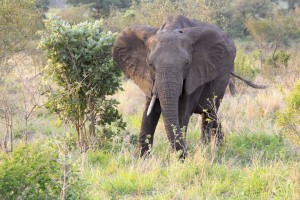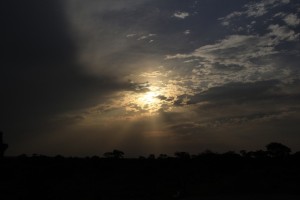
The CHPC conference was this year hosted in the Kruger National Park, South Africa. It was a stark contrast in so many ways, as software engineers, technologists, and high performance computing specialists gathered to discuss the finer points of the current and future state of computers in the midst of South Africa’s largest national park.
Yet, the contrast was engaging. I rose at 4:00 am in order to venture into the park on a game drive or guided hike, returning in time for breakfast. While I find it difficult to rise at 6:00 some days here in Muizenberg, I looked forward to driving in the chilled morning air, the open vehicle invited wind against my face, onto my chest through my thin, fleece jacket.
The prospect of seeing animals I have only a few times before, or may never again, was ample motivation.
 Personally, I find the elephants the most stunning. I could watch them all day, every day, and never grow wary. Of course, they are also one of the most dangerous. Incredibly smart, and highly protective of their young, Gilad and I experienced the very real threat of a young bull when he turned, squared his chest, and flared his ears as I brought our small car too close.
Personally, I find the elephants the most stunning. I could watch them all day, every day, and never grow wary. Of course, they are also one of the most dangerous. Incredibly smart, and highly protective of their young, Gilad and I experienced the very real threat of a young bull when he turned, squared his chest, and flared his ears as I brought our small car too close.
I quickly put the vehicle into reverse, and was able to ease the tension. A bead of cold sweat rolled down my neck, my hands shaking as I knew I had pushed too far, across his boundary.
A drive-through game park is at first consideration, an odd experience. One may ask why you would desire to spend days sitting in your car. Is this not similar to taking a golf cart through a zoo? While I prefer to be out on-foot (and this is an option, with a hired guide), there are certain benefits.
The animal population in parks such as Kruger in South Africa and Etosha in Namibia have grown-up for multiple generations in the presence of roads and vehicles. Because humans are not allowed outside those vehicles, most of the animals do not associate the vehicles with humans, and are relatively unafraid as every day their interaction is non-harmful. The chance of seeing elephants, zebra, hyaena, a great diversity of antelope, wildebeest, cheetah, lions, and many more are far greater from the comfort of your car, on designated roads, than if you are out on foot, even with an experienced tracker.
But from the North American point of view, the Kruger is an oddity, a national park with an airport and camp grounds with swimming pools, car washes, gas stations, and a restaurant chain which serves greasy burgers, fries, cake and beer.
 The lower 48 States do not have a park this large. At 19,633 square kilometres, the Kruger is similar to the area of the country of Holland. In California lies Death Valley National Park and wilderness, a smaller 13,650 square kilometres in comparison. With temperatures as high as 135F / 57C, Death Valley sees nearly one million tourists per year (and does not offer a full service airport, restaurant chain, or swimming pool).
The lower 48 States do not have a park this large. At 19,633 square kilometres, the Kruger is similar to the area of the country of Holland. In California lies Death Valley National Park and wilderness, a smaller 13,650 square kilometres in comparison. With temperatures as high as 135F / 57C, Death Valley sees nearly one million tourists per year (and does not offer a full service airport, restaurant chain, or swimming pool).
It is of course unfair to make further comparisons between U.S. and South African parks. The size, type of tourists, and funding are completely different. Yet, I find myself frustrated, perhaps, for what is an obvious lack of sustainability in Kruger. Office mate and friend Gilad and I were never, not once asked to show ID as we drove into the walled camps at night, nor were we checked for our camping permit at the camping site. We could have come and gone freely, during the entire four days, likely far longer.
I have to wonder how this lack of attention to security is present at a larger scale, and how it relates to the well-known issue of rhino and elephant poaching?
According to the Kruger National Park, “Out of the 631 rhinos that had been killed by poachers between January and 6 August 2014, a shocking amount of 408 were killed in the Kruger National Park. Ferreira said that in order to protect these species, they would have to be removed from areas where they are in threat of being poached.”
With the Asian black market growing, where the astounding $65,000 USD per kilogram paid to poachers is far greater than a lifetime of earning for the average South African, the motivation to continue to kill these animals for their horns is impossible to ignore.
One possible solution includes an increase in armed response, with international policies enabling cross-border pursuits. But poachers are well armed (and well connected), the odds are in their favour. Ranchers more often cross fire with poachers than do Park officials, resulting in unfortunate fatalities. In Namibia, ranchers are reluctant to bring rhino onto their farms, despite the financial benefit, for the lives of their families are at great risk.
An effort to move hundreds of rhinos to other national parks, inside or outside of South Africa, and private game preserves is under way. But transporting one rhino out of South Africa will cost approximately $45,000. Further more, this would need to be conducted in secret in order that poachers do not know the new locations. In a country ripe with corruption, for how long will the locations be unknown?
Many rhino are de-horned, in order to curb the poachers appetite to kill these animals. Analyst are studying the effect of moving a vast storehouse of rhino horns in the hands of the Parks service into the black market, in theory reducing the value, over time, and offsetting the pressure on live animals. The long term effect is yet being conclusively determined.
At current counts, only 29,000 rhinos of the estimated 500,000 in the early 1900s remain on the planet. In 2011, the Western Black Rhino was declared extinct. Confrontation between poachers and Park officials, and more often private ranchers often prove fatal. There is no concern for human life when the stakes are so incredibly high.
It is unclear how this will end, as the park is simply too large to patrol by vehicle or on foot. Perhaps use of drones will give favour to the wardens. The NBC article “Drones Used to Stop Elephant and Rhino Poachers in Africa” discusses one attempt to put drones to use. National Geographic offers, “NatGeo: Fighting Poachers with Guns, Dogs, and Drones” as an overview of the current situation. And the BBC tells the story of “Poachers, We’re Watching You“, a camera and bio-monitor embedded in the rhino’s horn which alerts a stand-by, helicopter team to the death of a rhino such that the poachers may be apprehended before they take the life of many more animals that same evening.
The consensus is that we must reduce demand in the countries in which rhino horns and elephant ivory are consumed. But that takes time. We must protect these animals for as long as it takes, else we risk losing them permanently.
(Gilad and I did not see a rhino in Kruger National Park)
On a positive note, thank you Gilad for an incredible four days. I enjoyed every minute of your company. Let’s be certain to do it again, some day soon.


























